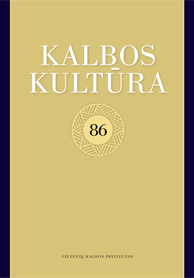KALBOS AKTAI NAUJOSIOS ROMUVOS (1931–1940) HIGIENOS IR KOSMETIKOS REKLAMOSE
SPEECH ACTS OF HYGIENE AND COSMETICS ADS IN THE NAUJOJI ROMUVA (1931–1940)
Author(s): Agnė AleksaitėSubject(s): Theoretical Linguistics, Applied Linguistics, Pragmatics, Interwar Period (1920 - 1939), WW II and following years (1940 - 1949), Marketing / Advertising
Published by: Lietuvių Kalbos Institutas
Keywords: linguistic pragmatics; speech acts; representatives; directives; commissives; expressives; hygiene ads; cosmetics ads; the Naujoji Romuva;
Summary/Abstract: The object of study of this article is the speech acts of ads for hygiene and cosmetics products in the Naujoji Romuva (NR) (1931–1940). The empiric material, repetitive ads excluded, consists of 176 ads for hygiene and cosmetics products that are analysed in this article on the basis of the theory of speech acts. Although, taking into account the economic and cultural level in Lithuania of that time, the number of advertisements was limited due to the scarcity of supply and sceptical attitudes of the society (Jankevičiūtė 2015: 29), the scant empirical material from the NR publication showcases certain trends in hygiene and cosmetics ads in Lithuania between the two world wars. The goal of the article is to identify the speech acts and micro acts that prevail in the NR hygiene and cosmetics ads from 1931–1940. The study has showed the following categories of speech acts to be used in ads for hygiene and cosmetics: (1) representatives (82.7%); (2) directives (12.6%); (3) commissives (3.6%), and (4) expressives (1.1%). No declarative speech acts were found in the ad copy researched. A qualitative analysis of the representatives has revealed that the more prevalent are the micro acts of assertion (50.2%), praise or boasting (25.5%), and information (18.7%), while the presence of the micro acts of assumption (3.3%), condition (1.6%), and cajolement (0.7%) is scarce. An analysis of the directives in the ads has showed that the micro acts of encouragement (76.2%) and instruction (19%) occur more frequently, and the micro acts of requesting (3.6%) and advising and recommending (1.2%) are very rare. The rare commissives (3.6%) in the ads appearing in the periodical that was in circulation between the two world wars are split into the micro acts of (1) promising (95.8%) and (2) assuring (4.2%). The expressives that make a seldom appearance (1.1%) in hygiene and cosmetics ads in the NR of the period between 1931 and 1940 can be divided into the micro acts of (1) emotions (60%) and (2) thanksgiving (40%).
Journal: Bendrinė kalba (iki 2014 metų – Kalbos kultūra)
- Issue Year: 2019
- Issue No: 92
- Page Range: 1-35
- Page Count: 35
- Language: Lithuanian

